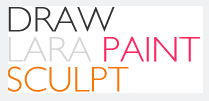 Not that I’m counting the days, but in just over three months I start my first year at LARA (London Atelier of Representation Art). LARA is one of the UK’s leading schools teaching representational art and traditional painting and drawing techniques. I was lucky enough to be able to take their figure drawing workshop in October last year, tutored by Alex Heath, and got a lot out of it. LARA is based in an old Marmite Factory in Vauxhall, London and has been running since 2008. Like many ateliers, the focus is on work from the life model. Single poses range from one week to a month under constant lighting conditions using the “sight- size” method. Along with daily drawing from the life model, I will spend my first year drawing from casts. In the second and third years, work from the life model continues but work in paint is introduced, using a limited palette of five colours. I’m hoping also to have the opportunity to gain some experience in portraiture, still life and landscape. These are huge subjects in their own right so I am not sure at the moment whether there is the much opportunity for this at LARA. Hopefully I’ll be able to make some time to pursue those interests in my own time, perhaps with short courses outside term time. It’s going to involve some exciting times for myself and my partner. The plan is that I’ll start the course in September, staying in South London temporarily while we house-hunt and get set up. After 10 years as a lawyer it feels like a shift of pretty monumental proportions. I’m incredibly eager to get started but it’s also slightly terrifying! I’ll be documenting my progress on this blog – so hopefully that’ll provide an interesting window on my experiences.
0 Comments
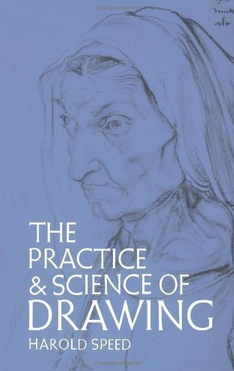 A particular favourite resource of mine, the Practice and Science of Drawing by Harold Speed, is a worthwhile acquisition for anyone interested in getting a solid foundation in representational drawing. Drawing is the bedrock of all painting and I've been very careful to resist the urge to jump into painting at the expense of developing a solid grounding in drawing. My efforts in improving my drawing are ongoing but I've learnt a lot from Harold Speed The Practice and Science of Drawing, first published in 1917, tackles the subject of drawing from two sides, first looking at line drawing and secondly at mass drawing. The section on mass drawing is most relevant to painters and, in fact, 'drawing' as Speed uses the term in this second section is, in effect, drawing with paint. This makes the exercises he suggests particularly relevant to me, in the sense that they consciously prepare the aspiring artist for work in oil at a later stage. 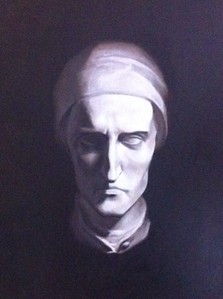 This is a cast painting of a mask of Dante that I did in 2013. It is probably between this and the St Jerome (which my first cast painting) as to which is my most successful. I completed the painting in a relatively short space of time and I really like the atmosphere and depth. One of the things I am always trying to be more sensitive to is my handling of edges. The sense of depth in this painting is largely down to that aspect being successful. I also feel the overall value relationships have a clear logic to them and are fairly convincingly resolved. Although I managed to avoid getting too fiddly, the brushwork could be broader and that would, I think, have improved the sense atmosphere further. I've written elsewhere that I feel my work has a heavy and sombre feel and I think trying to introducing some bravura brushwork may help with that. Working with a limited palette may be a factor too, but I don't think that's the overriding reason. At the time of writing it has been some time since I did a cast painting but I am currently working on a small painting of a skull. I've been trying to work in a broader way on that piece and will post the results here once it is finished. 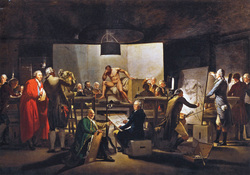 There are some fantastic resources for people like me who have been trying to follow a broadly 'academic' programme of study. Essentially the method involves a series of distinct stages, beginning with copying "from the flat" (i.e. copying drawings by the great artists of the past), drawing and painting from antique sculpture and figure drawing and painting, moving on to portraiture, still life and culminating, traditionally, in independent work on large scale multi-figure historical, religious and allegorical paintings. The process is eloquently described in the You Tube video from the Angel Academy. Without being surrounded by heaps of other students following the same programme, I've found it difficult (or, rather, boring) to be too rigid about following the stages in sequence. So, for better or worse, I've skipped about a bit! Below are a selection of pages that I like to refer to in my studies, which may be of interest: How an Impressionist Sees (Darren Roussar) (part 1 of 3 parts - parts 2 and 3 also available from same site); Step by Step Figure Painting (Sofia Welch of LARA) (part 2 also available from the same site); Sag Harbor Fine Arts Academy at Grenning Gallery - class notes; Angel Academy of Art You Tube Video (part 1 of 3 parts - parts 2 and 3 also available from same site); It has, to say the least, been a rather haphazard process for me, in terms of trying to find reliable information. There are lots of different approaches and variations on themes out there but these links are some of the ones that I have found to be the most comprehensive and comprehensible! 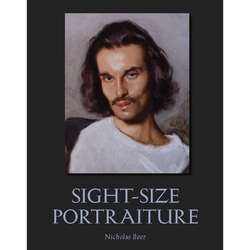 This book is probably the one I refer to most often. It was written by Nick Beer, formerly senior tutor at the Charles H Cecil Studio in Florence and the principal of Sarum Studio in Salisbury (see under Websites for more information). It has formed the backbone of my self-directed study over the last few years. Its very nicely written and contains extremely useful information, particularly on materials and painting mediums and the 'philosophy' of naturalistic painting. The book follows a series of projects from cast drawing I'd highly recommend picking up a copy to anyone interested in studying classical drawing and painting. 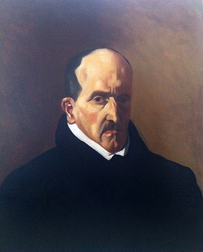 Here's the latest piece to come off the easel. It is a copy of a portrait by Diego Velasquez. I haven't quite captured the essence of the original but I'm still very pleased with the results. This is the first master portrait copy I've done and it was an enjoyable exercise in studying Velasquez's technique. I did the copy from a poster which I ordered online. Having set up the poster, I firstly did a fairly quick sight-size charcoal drawing - just the outline, shadow line and key features. I then transferred that to a neutral toned canvas. I lifted out some of the lights with a rag dipped in a little turps and darkened the shadows, keeping the paint turpsy and limiting my palette to just black and raw umber. I had some difficulty in getting the proportions of the head correct. Visually it seemed to be too wide and squat but when I measured from the original my copy was actually coming up longer and narrower. It took quite a bit of adjusting before I was happy with it. Having got the basic shapes reasonably resolved I then started building up layers of colour with increasingly oil rich medium. The palette was originally just lead white, yellow ochre, light red, raw umber and ivory black. Towards the end I was having difficulty getting a sufficiently pink tone for the lips and ears, so I added some English red. I toyed with trying Vermillion instead but the English red was the right call. The image I was copying from seemed somewhat yellow, which I imagine is due to the age of the original and the yellowing of the varnish. I did not want to reproduce that to too great a degree, but I did go over the final painting with a light stumble of yellow ochre. Overall a very useful learning experience and, I feel, a successful painting, even if I haven't quite captured the precise characteristics of the original. |
Ben Laughton SmithContemporary works of art in the classical tradition. Archives
March 2021
Categories |
Proudly powered by Weebly
 RSS Feed
RSS Feed